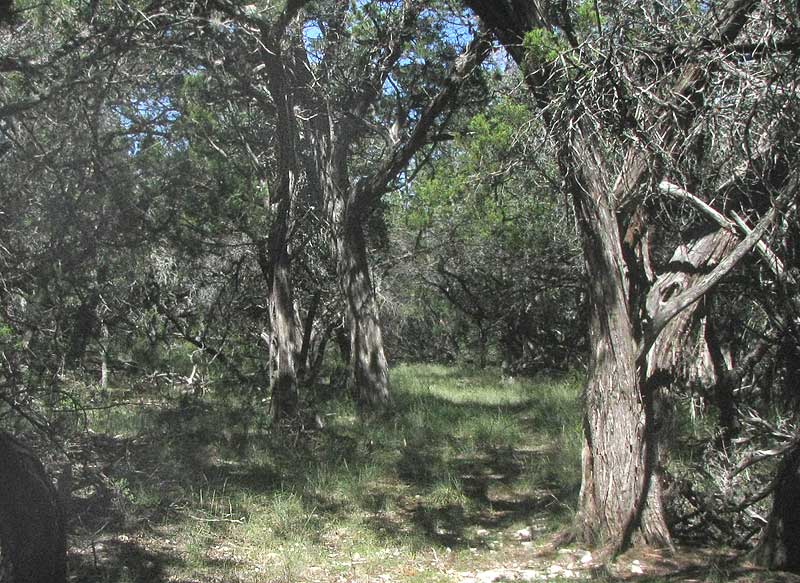
Trail through Ashe Junipers on hill near Juniper House
An Excerpt from Jim Conrad's
NATURALIST NEWSLETTER
October 13, 2013
Issued from the valley of the Dry Frio River in northern Uvalde County, southwestern Texas, on the southern border of the Edwards Plateau, USA

While thinking about why people kill their Ashe Junipers, saying that the trees "suck up" too much precious water and are invasive -- despite studies showing the opposite -- I came upon the concept of "group polarization." Polarization occurs when a group makes decisions that are more extreme than the initial inclination of its members. Wikipedia goes further into the matter at http://en.wikipedia.org/wiki/Group_polarization.
One explanation for why group polarization takes place is called the "social comparison theory." It postulates that when people belong to a group they pay attention to how others think. In order to gain acceptance, they take positions similar to everyone else’s, but a little more extreme, thus not only making clear that they agree with the group’s beliefs, but even that they are to be admired for "leading in the right direction."
That theory sounds right to me, and my experience is that normally polarized groups go beyond that. For example, around here my impression is that those most aggressively ridding the landscape of junipers belong to a polarized group consisting of folks conspicuously championing conservative traditional values -- flags by doors, quoting Bible verses, etc.
I'm guessing that conservative traditional values and killing junipers got lumped together because cattle need grasslands, not juniper woods, and in this area cattle and goat ranchers, who normally are conservative folks with traditional values, are much esteemed. People see ranchers clearing junipers, even receiving government subsidies to help them do so, so if ranchers and the government are against junipers, other "good, all-American citizens" also should be against junipers.
The polarization of groups who lump unrelated issues is dangerous. By definition, group polarization works against following The Middle Path. Though humans are born with a rainbow of differing, genetically based biases and needs, healthy societies average out those often-conflicting impulses into societal norms and behaviors more or less distributed along The Middle Path. During human evolution, until now, that Middle Path has been a sustainable one.
What happens when The Middle Path is abandoned? We'll see what happens to the US if Congress continues avoiding the Middle Path. The thing that happens when members of a polarized group kill junipers because they wish to be good neighbors is that soil erosion results; aquifers get plugged with sediment from the erosion; sunlight-glare-absorbing, cooling, oxygen-producing greenery and wildlife cover are removed from the landscape, and; beautiful, worthy, natural beings meant to live exactly here are destroyed on the false grounds that they "suck up water" and are invasive.
This isn't to say that junipers should be allowed to grow everywhere. Historically, juniper numbers were controlled by occasional large fires. However, with roads and fenced-in ranches, now such fires are suppressed and junipers can take over to the exclusion of nearly everything else. Sometimes the removal of junipers actually results in increased biodiversity.
In our area The Middle Path with regard to Ashe Junipers would lead to a landscape mosaic where junipers are cleared from some areas, but in others are granted sanctuary. Here in the recharge zone of important aquifers, juniper woodlands would be honored for contributing to the aquifers' recharge. But, nowhere would junipers be killed just because that's what's done by good, all-American neighbors.